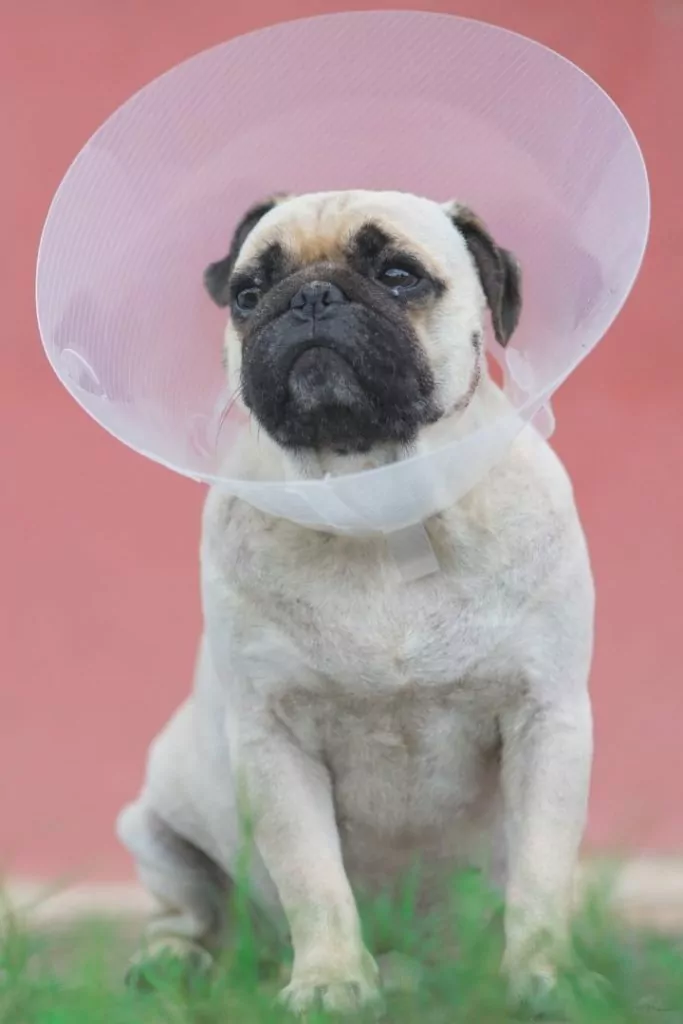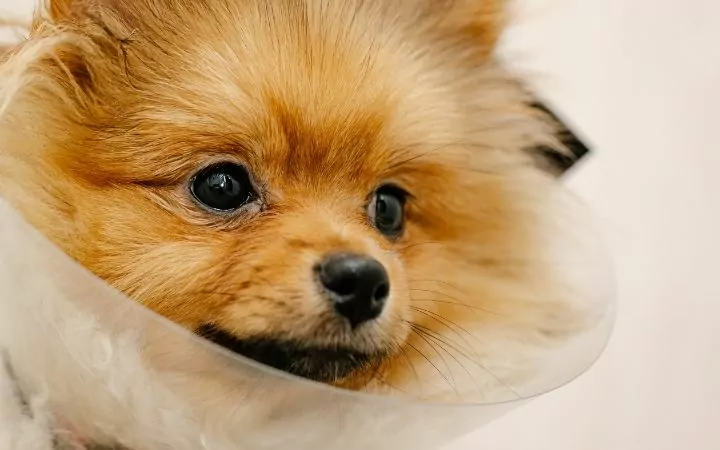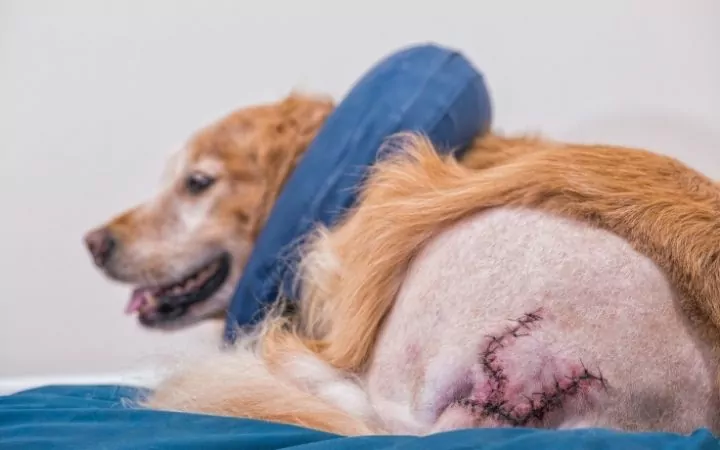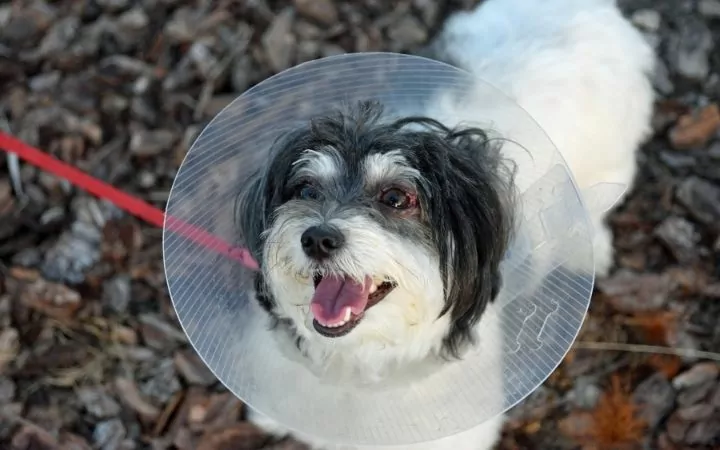Everyone knows the Cone of Shame. Its real name is the Elizabethan collar (a.k.a e-collar), and it is actually a very crucial and vital part of the veterinary world. The giant plastic protective device to keep your dog/cat from self-mutilating.
The Birth of the Collar of Shame
The Elizabethan Collar gets its name from mimicking the ruffles worn by wealthy individuals during the Elizabethan era and invented by Frank L. Johnson in 1962 after taking a thin sheet of plastic and tying it around a dog’s neck. He then decided to call it the Elizabethan collar (e-collar) for the reason stated above.

Since then, the e-collar has become a staple in every veterinarian’s office. Nicknamed “The Cone of Shame” because dogs often look guilty when wearing it. However, it is anything but shameful.
The e-collar has successfully reduced and prevented dogs from further traumatizing themselves over the years. You ever had a mosquito bite, and no matter what you did, you can’t stop scratching it? You know you’re not supposed to, but the scratching gives you some relief.
That’s similar to pets, except they are not aware of the negative consequences scratching, biting, and licking can do. That’s where the tough love aspect comes in. You are actually helping your dog or cat allow themselves to properly heal from surgical procedures.
Pets, like your dog, will use licking to alleviate pain. They may do so temporarily, but they are also introducing the wound/surgical site to a whole new host of bacteria found in their mouth. So they are essentially creating a quick fix while creating a much bigger problem.
Besides protecting pets from irritating their surgical sites, it also protects pets from messing with wounds that are trying to heal, any fungal or bacterial infections, and behavioral issues involving self-mutilation.
Important Information About the Elizabethan Collar for Dogs

Dogs will sometimes find it hard to find balance with the e-collar and need your assistance before getting used to it. Owners are often nervous that their dog cannot eat or drink with it on.
In these cases, it’s essential to use a shallow bowl or plate for their food and possibly hold the water up to their face.
Rest assured, an adequately fitted e-collar does not prohibit your dog from getting its daily calories. If you feel the size is too big or long, then make sure to speak with your veterinarian. The e-collar shouldn’t be too tight but not loose either. This ensures your dog cannot get it off (dogs get really creative when trying to take it off, LOL!).
Two fingers should be able to fit comfortably under the e-collar tie. The length should go past the dog’s nose and snout. If it is shorter than their snout, they will not use it for its intended purpose and the dog will be able to get around it.
Always assist your dog if they are banging into objects or getting stuck in narrow places. It is best to keep them in a wider area for the time being while they need the e-collar. Failure to do so can create unwanted tension for your dog.
Walking your dog can be done by wearing the e-collar. It is best to use a leash and hand walk rather than just letting your dog out with free-range. Doing this may result in your dog getting tangled in bushes or other plants that can cause distress and possible injury.
Make sure to keep the e-collar clean with a damp towel or cloth, as it can get messy and pick up dirt and food around its environment. If you need to remove the e-collar to clean it, keep a watchful eye on your dog. They may take that opportunity to lick themselves and damage the area you are protecting.
Why do Cats Need to Wear an E-Collar?

Cats need e-collars for the same reason dogs do. To prevent them from licking and further damaging a surgical site or present injury. Cats are even better contortionists than dogs and can get to those hard-to-reach spots.
This makes it crucial to use an e-collar protective device. We stated above that the e-collar could be removed to assist your dog temporarily, but we do not suggest the same for your cat. Once the e-collar is off, your cat may hide, which will make it difficult to resize and refit it and therefore put your cat at risk for self-mutilation or a secondary infection.
Cats will try even harder than dogs to remove the e-collar, so make sure you spend some time supervising while your cat adjusts. This is to help and prevent your cat from getting its paws stuck or injuring itself.
What you Should Expect With Regards to the Elizabethan Collar
Pets will take a bit to adjust but rest assured they will adapt. Always make sure to keep it on as much as possible. Never take it off when your eyes are not on your pet, and with cats, avoid taking it off at all.
Shallow and raised bowls can help alleviate some confusion and frustration for your pet while eating and drinking. Making sure the size is proper is also very important. If you feel it is not doing what it is supposed to, do not hesitate to call your veterinarian.
Alternatives to the E-Collar for Your Pets

There are many different versions of the e-collar, and finding one that works best for your pet is crucial to them wearing it. Keeping them comfortable and safe are both valid, essential parts of the healing process. Below is a list of alternative protective e-collars.
Cloth/soft e-collar- the original e-collar is plastic, but other types are made with fabric. The downfall of these is that your dog/cat may be able to manipulate it to fold back. However, it can be more comfortable for your pet and thus less stressful for you.
Inflatable cone- this e-collar inflates and is nicknamed the doughnut. It works well in preventing your pet from getting to specific areas. However, it does not do well in avoiding eye or face trauma. This is because your pet can still successfully rub its face while wearing it.
T-shirt- a t-shirt works well with certain types of pets. Not every pet will accept a t-shirt as a means of deterrence. In these pets, it can create more issues because it will trap moisture from licking. It is best only to use this method in pets that will tolerate it and are being supervised.
Bite Not Collar- The Bite Not Collar allows your pet better peripheral vision and be more active while protecting surrounding areas from being licked or bitten. It is also not recommended with face or eye injuries because it will not prevent your pet from rubbing their faces.
Summary

The e-collar wasn’t invented to torture your pets. It was developed to keep them safe. Veterinarians do not want to see your pets further injure themselves and want them to thrive while healing.
E-collars only need to be worn for 10-14 days or until recheck making it a short amount of time for your pets to tolerate it.
When in doubt, think of the amount you paid for the e-collar vs. the amount (and stress on both you and your pet) to treat self-inflicted trauma. That will allow you to see 10-14 days as a short amount of time vs. long.

